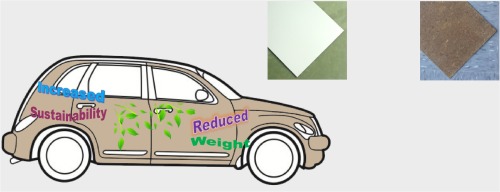Journal of Cleaner Production ( IF 9.7 ) Pub Date : 2018-02-24 , DOI: 10.1016/j.jclepro.2018.02.257 Yingji Wu , Changlei Xia , Liping Cai , Andres C. Garcia , Sheldon Q. Shi

|
To replace glass-fiber sheet molding compound (GF-SMC) using natural fiber-reinforced composites (NFRCs) in the automotive industry, this work intended to enhance mechanical properties and water resistance of NFRCs by impregnating magnesium hydroxide (MH) to kenaf fibers and fabricating composites using the vacuum bag resin transfer molding (VBRTM) technology. The modulus of rupture and tensile strength of modified composites were significantly increased by 73.9% and 54.6% compared with that of the regular NFRCs, respectively. Based on the scanning electron microscope observation, it was found that the MH impregnation significantly enhanced the compatibility of kenaf fibers and polymer matrix, benefiting to the mechanical-property improvements of the composites. Compared to the regular NFRC, the 24-h water absorption and thickness swelling of MH impregnated NFRC (MH-NFRC) were significantly reduced by 83.9% and 84.2%, respectively. When the composite density was factored in the comparison of MH-NFRC and GF-SMC, the specific modulus of rupture and tensile strength of MH-NFRC were 116.4% and 109.0% of the GF-SMC, respectively. Apart from the mechanical properties, the advantages of replacing GF-SMC by MH-NFRC were reflected in the reductions of energy consumption and environmental impacts. It was calculated that the energy consumption of fabricating MH-NFRC was decreased by 33.1% compared with GF-SMC. The comparisons of environmental impacts of MH-NFRC and GF-SMC were performed by life-cycle assessment (LCA) using the SimaPro software. The results demonstrated that the environmental burdens of the composites were reduced by 22.8%, when kenaf fibers were used. All major indices of environmental impacts of MH-NFRC, including the total Global warming, Acidification, Human Health (HH) cancer, HH noncancer, HH criteria air pollutants, Eutrophication, Ecotoxicity, Smog, Natural resource depletion, Habitat alteration, Water intake and Ozone depletion, were reduced by 13.66–51.91%, respectively. It was concluded that the newly developed NFRC had great potential for replacing the GF-SMC in automobile applications, with reduced energy consumption and environmental impacts.
中文翻译:

天然纤维增强复合材料的开发,具有可替代的机械性能,并降低了能耗和环境影响,可替代汽车玻璃纤维片状模塑料
为了在汽车工业中使用天然纤维增强复合材料(NFRC)代替玻璃纤维片状模塑料(GF-SMC),这项工作旨在通过将氢氧化镁(MH)浸入洋麻纤维中来增强NFRC的机械性能和耐水性。使用真空袋树脂传递模塑(VBRTM)技术制造复合材料。与常规NFRC相比,改性复合材料的断裂模量和拉伸强度分别显着提高了73.9%和54.6%。基于扫描电子显微镜观察,发现MH浸渍显着增强了洋麻纤维和聚合物基质的相容性,有利于复合材料的机械性能改进。与常规NFRC相比,MH浸渍的NFRC(MH-NFRC)的24小时吸水率和厚度溶胀分别显着降低了83.9%和84.2%。当比较MH-NFRC和GF-SMC的复合密度时,MH-NFRC的比断裂模量和拉伸强度分别为GF-SMC的116.4%和109.0%。除了机械性能外,用MH-NFRC代替GF-SMC的优势还体现在减少能耗和环境影响上。经计算,与GF-SMC相比,制造MH-NFRC的能耗降低了33.1%。使用SimaPro软件通过生命周期评估(LCA)对MH-NFRC和GF-SMC的环境影响进行比较。结果表明,复合材料的环境负担降低了22.8%,当使用洋麻纤维时。MH-NFRC对环境影响的所有主要指标,包括总的全球变暖,酸化,人类健康(HH)癌症,HH非癌,HH标准空气污染物,富营养化,生态毒性,烟雾,自然资源耗竭,栖息地变化,进水量和臭氧消耗分别减少了13.66–51.91%。结论是,新近开发的NFRC在汽车应用中具有取代GF-SMC的巨大潜力,并具有降低的能耗和对环境的影响。分别减少了13.66–51.91%。可以得出结论,新开发的NFRC在汽车应用中具有取代GF-SMC的巨大潜力,并具有降低的能耗和对环境的影响。分别减少了13.66–51.91%。可以得出结论,新开发的NFRC在汽车应用中具有取代GF-SMC的巨大潜力,并具有降低的能耗和对环境的影响。











































 京公网安备 11010802027423号
京公网安备 11010802027423号